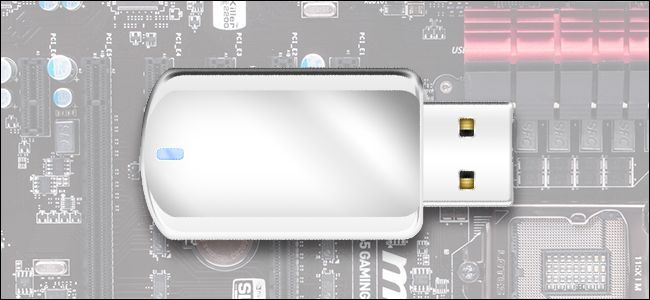We're all familiar with plugging in a USB cable or dongle into the external ports on our computers, but is it possible to plug a USB device directly into the motherboard so the device is hidden away and safely contained within the case of the computer? Read on as we show you how you can easily retrofit a computer with this feature.
Dear How-To Geek,
Two of your recent articles got me thinking. First you were talking about upgrading your computer to USB 3.0 and then a few weeks later you were talking about adding Bluetooth to your computer via USB dongle.
What if you wanted to add that USB dongle (or a flash drive or anything USB-based for that matter) to your computer but on the inside? I mean I don't need to plug and unplug the Bluetooth dongle; it could stand permanently plugged in forever for all I care. And what about people running operating systems off flash drives like XBMC or FreeNAS? I'm always paranoid that someone is going to unplug the OS flash drive and screw everything up. I'd be a lot happier if the flash drive was hidden inside the case.
Is that possible? Is there anyway to plug a USB dongle or flash drive right into the motherboard?
Sincerely,
Dongle Curious
In computing where there's a will there's a way, and as far as such matters go your request isn't particularly outlandish. It is quite possible to plug a USB dongle or flash drive directly into a motherboard.
Some motherboards, almost exclusively server motherboards, come with this feature for exactly the reasons you allude to: you can load lightweight operating systems on flash media and the best place for that flash media on a rack-mount server is safely inside the case.
Let's take a look at the SuperMicro X10SLH-F motherboard as an example of such server motherboard design. In the top-down photo below you can see the blue USB 3.0 port sticking straight up off the lower edge of the motherboard.
That port works just like the ports on the back on motherboard, accessible from the back of the computer case: just plug in any USB device and it's like you've plugged it into a traditional case port.
The demand for such internal USB ports on consumer motherboards is pretty low, however, so don't be surprised to find that you don't have one on your desktop computer. Don't let that stop your dream of internal USB hardware though as it's trivially easy to add it into your machine (as long as you have a free USB header inside).
Let's reference the same photo again. Slightly to the left of the USB port in the photo are three USB headers (two black USB 2.0 headers and one USB 3.0 header); the bank of three is indicated by the arrow in the photo below. While internal USB ports are rare on consumer motherboards, these headers (especially the USB 2.0 ones) are found on just about every motherboard around.
There are very inexpensive adapter cables/modules you can use to turn those headers into functional USB ports and they require no more work than opening your case and plugging them in. If you wish to convert a USB 3.0 header into an internal USB 3.0 port, you can do so with an adapter that plugs right in and provides a vertically oriented USB port (~$3) or you can use an adapter with a cable (~$6) if you need to position the dongle or flash drive for some reason (like your case is particularly shallow in depth).
The same adapters are available for USB 2.0 headers, also. Here's a vertical port adapter (~$11) and an adapter with a cable (~$4); both attach to USB 2.0 motherboard headers.
As long as you have an open header on the motherboard, a few bucks to spare, and a few minutes to open your case and plug the new adapter in, there's nothing standing between you and a hidden-inside-the-case USB installation.
Have a pressing tech question? Shoot us an email at ask@howtogeek.com and we'll do our best to answer it.



